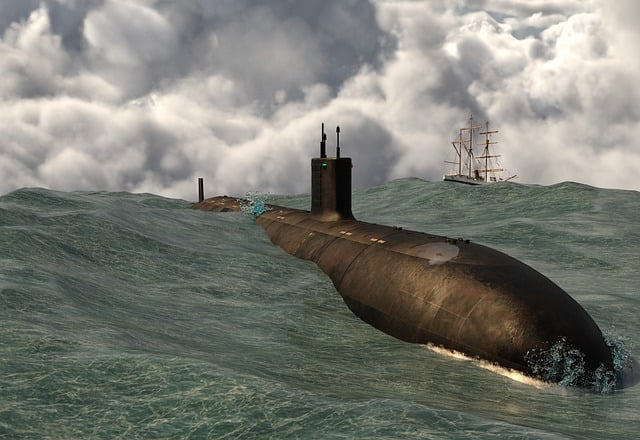Submarine salvage is a specialized field within marine salvage that involves the recovery of sunken submarines and their cargo. This complex and often perilous activity requires advanced technology, engineering expertise, and meticulous planning. The process of submarine salvage is driven by various motivations, including the recovery of valuable assets, investigation of accidents, and the prevention of environmental hazards. This article explores the techniques and challenges of submarine salvage, and presents notable operations that highlight the significance and intricacies of this demanding maritime endeavor.
Techniques in Submarine Salvage
Submarine salvage employs a range of sophisticated techniques tailored to the specific circumstances of each operation. One of the primary methods is the use of remotely operated vehicles (ROVs) and autonomous underwater vehicles (AUVs). These underwater robots can inspect and survey wreck sites with high precision, providing detailed images and data that help in planning the salvage operation. Equipped with cameras, sonar systems, and cutting tools, ROVs can operate in hazardous environments, reducing the risk to human divers.
Lifting and buoyancy techniques are also commonly used in submarine salvage. Lifting involves attaching lifting cables or chains to the submarine and using cranes or sheerlegs to hoist it to the surface. Buoyancy techniques, on the other hand, involve attaching inflatable lifting bags to the submarine. These bags are gradually inflated, providing the necessary buoyancy to lift the submarine off the seabed. These techniques require precise calculations and coordination to ensure the stability and safety of the submarine during the lift.
Cutting and sectioning are additional techniques used in submarine salvage, particularly when the submarine is heavily damaged or partially buried in the seabed. Underwater cutting tools, such as hydraulic shears and plasma torches, are used to cut the submarine into smaller, more manageable pieces. These sections are then lifted to the surface and transported for further analysis or disposal. This method minimizes environmental impact and maximizes the recovery of valuable materials.
Challenges in Submarine Salvage
Submarine salvage operations are fraught with challenges that necessitate careful planning and execution. One of the primary challenges is the depth and environment of the wreck site. Submarines can sink to great depths, often in remote or hazardous locations. Salvors must contend with factors such as poor visibility, strong currents, and extreme water pressures. These conditions can complicate the operation and pose risks to the divers and equipment involved.
The structural integrity of the submarine presents another challenge. Sunken submarines can be unstable and prone to further damage during the salvage process. Assessing the condition of the submarine and reinforcing it as needed is critical to prevent collapse or additional sinking during recovery.
Environmental considerations are also significant. Submarine wrecks can pose environmental hazards, including oil spills, the release of hazardous materials, and physical damage to marine habitats. Salvage operations must be conducted in a manner that minimizes environmental damage. This is particularly crucial when dealing with submarines carrying nuclear reactors or other hazardous materials. Containment and remediation efforts are essential to protect marine ecosystems and prevent long-term environmental harm.
Logistical and financial challenges also play a role. Submarine salvage operations often require significant resources, including specialized equipment, skilled personnel, and support vessels. Coordinating these resources and managing costs is essential for the successful completion of the operation. International cooperation may also be necessary, especially when the wreck is located in international waters or affects multiple jurisdictions.
Notable Submarine Salvage Operations
Several notable submarine salvage operations highlight the complexities and achievements of this field. These operations showcase the ingenuity, determination, and expertise required to recover sunken submarines and their cargo.
The USS Squalus
One of the earliest and most significant submarine salvage operations involved the USS Squalus. The Squalus was a U.S. Navy submarine that sank off the coast of New Hampshire in 1939 during a test dive. The sinking resulted in the deaths of 26 crew members, while 33 others were trapped in the sunken submarine. The U.S. Navy launched a daring and unprecedented rescue and salvage operation, led by Lieutenant Commander Charles “Swede” Momsen.
The first phase of the operation focused on rescuing the trapped crew members. Using the newly developed McCann Rescue Chamber, a specialized diving bell, the salvage team successfully rescued all 33 survivors. The next phase involved raising the sunken submarine. Divers attached lifting cables to the submarine, and a series of pontoons were used to provide buoyancy. After multiple attempts and several months of effort, the Squalus was finally raised to the surface and towed to a dry dock for repairs.
The successful salvage of the USS Squalus marked a significant milestone in submarine rescue and salvage operations. It demonstrated the effectiveness of new technologies and techniques, and it set a precedent for future submarine salvage efforts.
The Kursk
Another notable submarine salvage operation was the recovery of the Russian submarine Kursk. The Kursk sank in the Barents Sea in 2000 after a catastrophic explosion, resulting in the deaths of all 118 crew members. The Russian government, with assistance from international salvage teams, launched an ambitious and complex salvage operation to recover the submarine and investigate the cause of the disaster.
The first phase of the operation involved securing the wreck site and preparing the submarine for lifting. Specialized equipment, including ROVs and cutting tools, was used to sever the damaged bow section from the rest of the submarine. This step was necessary to facilitate the lifting process and ensure the stability of the submarine during recovery.
The next phase involved attaching a series of lifting cables to the submarine and raising it to the surface. A specialized lifting vessel, the Giant 4, was used for this purpose. The lifting process required precise coordination and careful monitoring to prevent further damage to the submarine. After several months of preparation and multiple lifting attempts, the Kursk was successfully raised to the surface and transported to a shipyard for investigation.
The successful salvage of the Kursk provided valuable insights into the cause of the disaster and highlighted the importance of international cooperation and advanced technology in submarine salvage operations.
The K-129
The recovery of the Soviet submarine K-129 by the United States, known as Project Azorian, is one of the most secretive and ambitious submarine salvage operations in history. The K-129 sank in the Pacific Ocean in 1968 under mysterious circumstances, and its wreck lay at a depth of over 16,000 feet. The U.S. government, motivated by intelligence and strategic interests, launched a covert operation to recover the submarine and its contents.
The operation involved the construction of a specialized salvage vessel, the Hughes Glomar Explorer, which was equipped with advanced lifting and retrieval systems. The vessel was designed to lower a massive claw-like device to the seabed, attach it to the submarine, and lift it to the surface. The operation faced numerous technical and logistical challenges, including the extreme depth, harsh environmental conditions, and the need for secrecy.
Despite these challenges, the salvage team successfully recovered a portion of the K-129 and its contents, including valuable intelligence materials. The operation remained classified for many years, but its successful execution demonstrated the potential of advanced technology and strategic planning in submarine salvage.
Conclusion
Submarine salvage is a highly specialized and challenging field that requires a combination of advanced technology, engineering expertise, and meticulous planning. The techniques employed in submarine salvage operations, such as the use of ROVs, lifting systems, and cutting tools, are continuously evolving to address the complexities of recovering sunken submarines.
The challenges of submarine salvage, including depth and environmental conditions, structural integrity, environmental considerations, and logistical constraints, necessitate careful planning and execution. Notable operations, such as the salvage of the USS Squalus, the Kursk, and the K-129, highlight the significance and achievements of this demanding maritime endeavor.
As technology advances and environmental awareness grows, the future of submarine salvage will be shaped by continued innovation, strategic planning, and international cooperation. Through these efforts, the marine salvage industry can effectively address the challenges of submarine recovery, safeguarding valuable assets, protecting marine environments, and enhancing maritime safety.
4o





